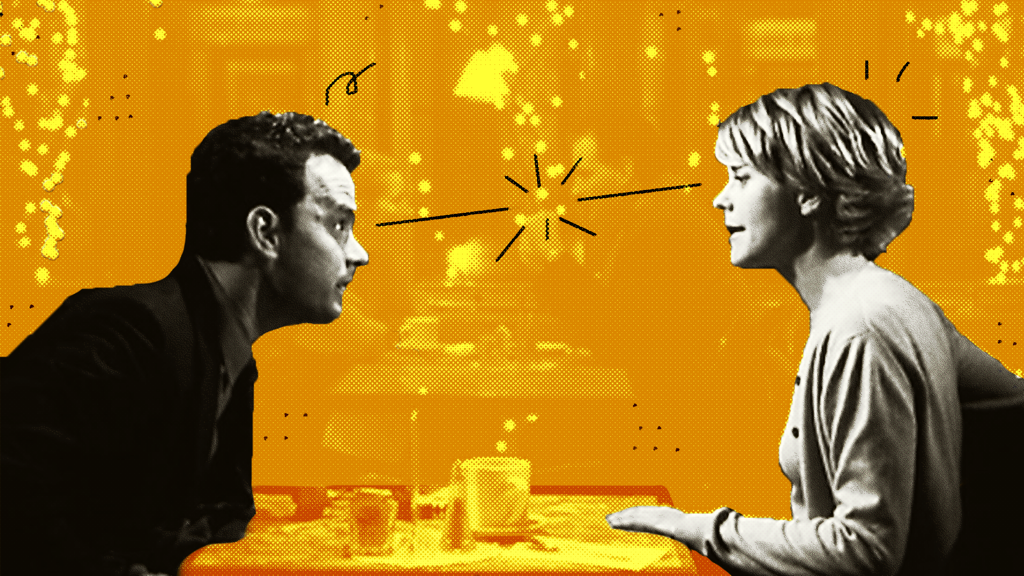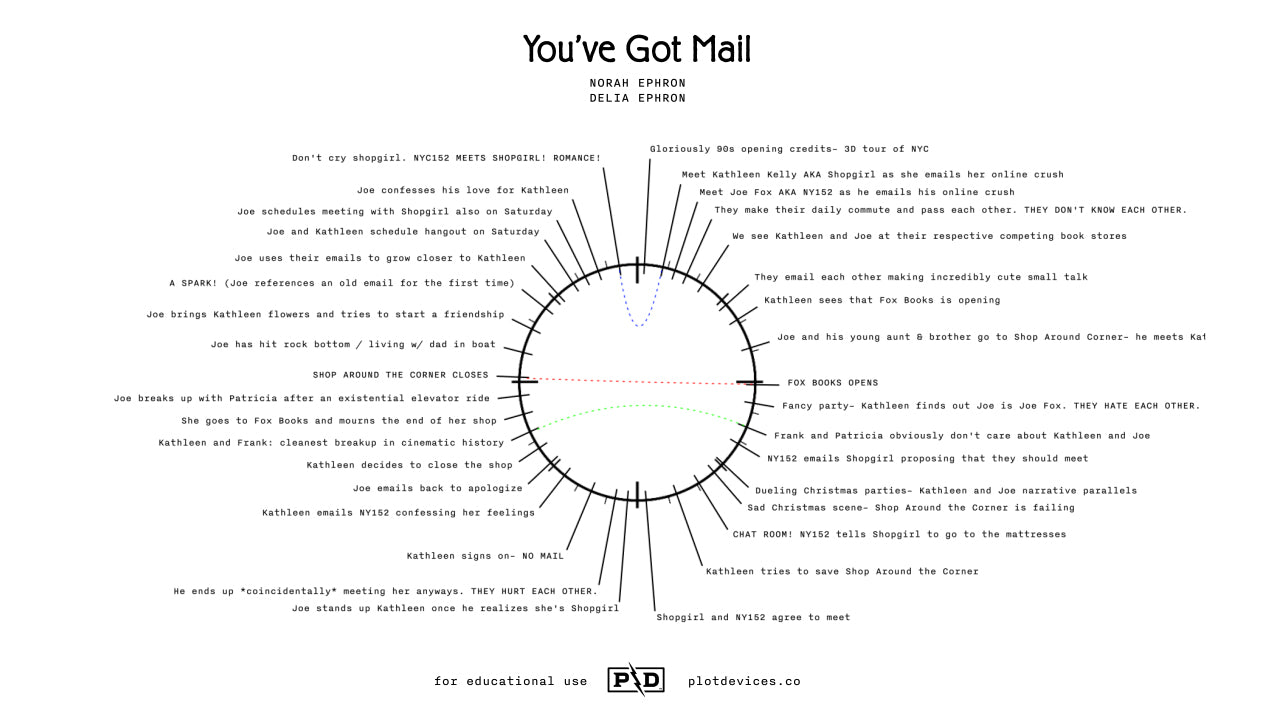Storyclock Research Log
You've Got Mail

For today's Storyclock Research Log, we analyzed Norah Ephron’s all-time classic romantic-comedy You’ve Got Mail! As usual, we watched the movie and used the Storyclock Notebook to visualize the episode's structure in the form of a clock.
Let's Break It Down
- Opening: Gloriously 90s opening credits– zooming through a digital rendering of the setting of our story, New York City.
- Normalcy/Normalcy Disrupted/Herald/Rational Approach/Acceptance: I would argue that the inciting incident of this story happens before the movie starts, which is Joe and Kathleen meeting online and beginning their secret relationship. In the typical “hero’s journey” structure you would spend the whole first quarter of the movie seeing Kathleen and Joe’s normal lives– they’ve got their bookstores, they’re unhappy in their romantic relationships, and they long for something greater (normalcy). Then they would stumble into a chatroom and feel this exciting new romance (normalcy disrupted), one of them would email the other (herald), they would think about what they’re doing and have doubts (rational approach), and then eventually go all in on their online pen pal thing. Ephron instead immediately throws you right into that relationship in the first scene. It’s simple, effective, and shows you the protagonists’ desires right away.
- Trailer Moments/Promise of the Premise: Joe and Kathleen’s love for one another developing online, their rivalry developing offline.
- Midpoint: Joe goes to a café to meet the love of his life: Shopgirl… who turns out to be Kathleen: his enemy!
- Things Get Worse: Joe decides to not go through with the meeting, but in a twist, he shows up and acts like it was a coincidence. The conversation is simultaneously filled-with-chemistry and mean spirited.
- Hero’s Last Resort: Joe musters up the courage to write a lovely apology email to Shopgirl.
- Game Over: Kathleen closes the Shop Around the Corner. Joe is living in his boat with his dad.
- Breakthrough and Rebirth/Break Into Act 3: Joe realizes that he’s in love with Kathleen. He brings her flowers and apologizes for everything he’s done. He proposes that they be friends and starts to drop subtle hints from their emails into conversation. There’s a spark.
- Hero Gains Upper Hand: Kathleen and Joe start to hang out a lot as friends. In real life they talk about Kathleen’s emails with “NY152”, Joe’s online persona. Joe disparages Kathleen’s online relationship because he’s fighting for her to see him as the man she’s in love with. He organizes a meeting between Kathleen and NY152, recites a moving speech, and then we all fall in love with Tom Hanks.
- Ultimate Breakthrough: Kathleen finds out Joe is NY152! She cries. He says “Don’t cry Shopgirl… don’t cry.” and then all of us cry.
- Final Image: “What a Wonderful World” plays as they kiss in the middle of a beautiful idyllic park. They live happily ever after.
Stuff That Stood Out To Me
When it comes to romantic-comedies, You’ve Got Mail is my crown-jewel. Written and directed by Norah Ephron, starring Tom Hanks and Meg Ryan, and a jam-packed 90s soundtrack featuring music by The Cranberries? Come on. Structurally, I figured this movie would be a great one to analyze because the hero and heroine are treated equally throughout the story– one would say that they are even both protagonists.
Let’s actually dive into the “protagonist” subject. If we’re calling the protagonist the hero that goes through the most change throughout the story, that would have to go to Joe. He of course starts out as an amazing heartthrob online, but is an enormous douchebag in real life. He’s a corporate sleazebag, brags about his superstore taking out local businesses, and treats Kathleen like garbage. By the end of the film he’s learned to empathize, figured out what he wants out of his life (to not be like his father) and fallen in love. Joe also controls a lot of the action in the final 30 minutes of the film. While Joe goes through the most change, the point-of-view of the story seems to be more Kathleen’s, with Ephron giving her a lot of crucial scenes that would typically go to the protagonist.
You’ve Got Mail plays a lot with these dual protagonists, showing the two characters on parallel tracks. They’ve got their respective book stores, their quirky significant others, and even dueling Christmas parties!
- Symmetrical moment: Fox Books opens / Shop Around the Corner closes.
- Symmetrical moment: The first time we see Shopgirl and NY152 emailing each other / They meet in real life.
- Symmetrical moment: Frank is obsessed with himself / Frank and Kathleen break up.
- On the inner cover of the Storyclock Workbook, we give examples of common story structures in different genres. For romantic-comedies, we gave an example of a simple 4 act structure: 1) They don’t know each other 2) They hate each other 3) They hurt each other 4) They love each other. Now we’re not saying that all stories have to fit into this preconceived mold… but this movie totally does.
In a 1998 interview, Norah Ephron gushes about her love for story structure. With You’ve Got Mail, she was able to create a beautifully structured story, showing tons of symmetry between the characters' journeys and narratively when laid out in a clock. You can analyze other films story structures with the Storyclock Notebook! And even outline your own with the Storyclock Workbook!





